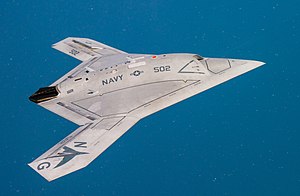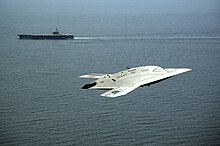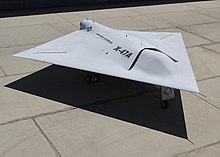-
designation X-47A Pegasus, while the follow-on naval version is designated X-47B. The US Navy did not commit to practical UCAV efforts until mid-20009 KB (802 words) - 04:07, 26 February 2018
- begin quote from:
-
The Northrop Grumman X-47B is a demonstration unmanned combat air vehicle (UCAV) designed for aircraft carrier-based operations. Developed by the American38 KB (3,689 words) - 17:55, 20 June 2018
Northrop Grumman X-47B
X-47B UCAS-D 
An X-47B demonstrator over the U.S. Navy's Atlantic Test Range Role National origin United States Manufacturer Northrop Grumman First flight 4 February 2011 Primary user United States Navy Number built 2 Program cost US$813 million (2012 estimate)[1] Developed from Northrop Grumman X-47A Pegasus Developed into Northrop Grumman X-47C The Northrop Grumman X-47B is a demonstration unmanned combat air vehicle (UCAV) designed for aircraft carrier-based operations. Developed by the American defense technology company Northrop Grumman, the X-47 project began as part of DARPA's J-UCAS program, and subsequently became part of the United States Navy's Unmanned Combat Air System Demonstration (UCAS-D) program. The X-47B is a tailless jet-powered blended-wing-body aircraft capable of semi-autonomous operation and aerial refueling.[2]The X-47B first flew in 2011, and as of 2015, its two active demonstrators have undergone extensive flight and operational integration testing, having successfully performed a series of land- and carrier-based demonstrations.[3][4][5] In August 2014, the US Navy announced that it had integrated the X-47B into carrier operations alongside manned aircraft,[6] and by May 2015 the aircraft's primary test program was declared complete.[7] Northrop Grumman intends to develop the X-47B into an operational aircraft, the MQ-25 Stingray, which will enter service in the 2020s.[8][9][10] The X-47B demonstrators themselves were intended to become museum exhibits after the completion of their flight testing, but the Navy later decided to maintain them in flying condition pending further development.[11][12]Contents
[hide]Design and development[edit]
Origins[edit]
The US Navy did not commit to practical UCAS efforts until 2000, when the service awarded contracts of US$2 million each to Boeing and Northrop Grumman for a 15-month concept-exploration program.[13] Design considerations for a naval UCAV included dealing with the corrosive saltwater environment, deck handling for launch and recovery, integration with command and control systems, and operation in an aircraft carrier's high-electromagnetic-interference environment. The Navy was also interested in procuring UCAVs for reconnaissance missions, penetrating protected airspace to identify targets for following attack waves.[14]Northrop Grumman's proof-of-concept X-47A Pegasus, which provided the basis for the X-47B's development, first flew in 2003.[15]The J-UCAS program was terminated in February 2006 following the US military's Quadrennial Defense Review. The US Air Force and Navy proceeded with their own UAV programs. The Navy selected Northrop Grumman's X-47B as its unmanned combat air system demonstrator (UCAS-D) program.[16] To provide realistic testing, the company built the demonstration vehicle to be the same size and weight as the projected operational craft, with a full-sized weapons bay capable of carrying existing missile systems.[17][18][19][20]The X-47B prototype rolled out from Air Force Plant 42 in Palmdale, California, on 16 December 2008. Its first flight was planned for November 2009, but the flight was delayed as the project fell behind schedule. On 29 December 2009, Northrop Grumman oversaw towed taxi tests of the aircraft at the Palmdale facility,[16] with the aircraft taxiing under its own power for the first time in January 2010.Flight testing[edit]
The first flight of the X-47B demonstrator, designated Air Vehicle 1 (AV-1), took place at Edwards Air Force Base, California, on 4 February 2011.[21][22] The aircraft first flew in cruise configuration with its landing gear retracted on 30 September 2011.[23] A second X-47B demonstrator, designated AV-2, conducted its maiden flight at Edwards Air Force Base on 22 November 2011.[24]The two X-47B demonstrators were initially planned to have a three-year test program with 50 tests at Edwards AFB and NAS Patuxent River, Maryland, culminating in sea trials in 2013.[24][25] However, the aircraft performed so consistently that the preliminary tests stopped after 16 flights.[26] Thereafter, the Navy decided to use the aircraft to demonstrate carrier launches and recoveries, as well as autonomous inflight refueling with a probe and drogue. In November 2011, the Navy announced that aerial refuelling equipment and software would be added to one of the prototype aircraft in 2014 for testing.[27] The Navy also affirmed that the demonstrator aircraft would never be armed.[26] In 2012, Northrop Grumman tested a wearable remote control system, designed to allow ground crews to steer the X-47B while on the carrier deck.[28]In May 2012, AV-1 began high-intensity electromagnetic interference testing at Patuxent River, to test its compatibility with planned electronic warfare systems.[29] In June 2012, AV-2 arrived at Patuxent River to begin a series of tests, including arrested landings and catapult launches, to validate the ability of the aircraft to conduct precision approaches to an aircraft carrier.[30] The drone's first land-based catapult launch was conducted successfully on 29 November 2012.[31][32]On 26 November 2012, the X-47B began its carrier-based evaluation aboard the USS Harry S. Truman (CVN-75) at Naval Station Norfolk, Virginia.[33] On 18 December 2012, the X-47B completed its first at-sea test phase. The system was remarked to have performed "outstandingly", having proved that it was compatible with the flight deck, hangar bays, and communication systems of an aircraft carrier. With deck testing completed, the X-47B demonstrator returned to NAS Patuxent River for further tests.[34] On 4 May 2013, the demonstrator successfully performed an arrested landing on a simulated carrier deck at Patuxent River.[35] The Navy launched the X-47B from the USS George H.W. Bush (CVN-77) on the morning of 14 May 2013 in the Atlantic Ocean, marking the first time that an unmanned drone was catapulted off an aircraft carrier.[36][37] On 17 May 2013, another first was achieved when the X-47B performed touch-and-go landings and take-offs on the flight deck of the USS George H.W. Bush while underway in the Atlantic Ocean.[38]On 10 July 2013, the X-47B launched from Patuxent River and landed on the deck of the George H.W. Bush, conducting the first ever arrested landing of a UAV on an aircraft carrier at sea.[5] The drone subsequently completed a second successful arrested landing on the Bush, but a third attempt was diverted to the Wallops Flight Facility in Virginia after a technical problem was detected, aborting the planned carrier landing.[39] One of the drone's three navigational sub-systems failed, which was identified by the other two sub-systems. The anomaly was indicated to the mission operator, who followed test plan procedures to abort the landing. The Navy stated that the aircraft's detection of a problem demonstrated its reliability and ability to operate autonomously.[40]On 15 July 2013, the second X-47B demonstrator, designated 501, was forced to abort another planned landing on the Bush due to technical issues.[41][42] Officials asserted that only one successful at-sea landing was required for the program, though testers were aiming for three, and only two out of four were achieved.[42] The Navy continued flying the two X-47B demonstrators through 2014, after the service was criticised for prematurely retiring the testbeds.[43] The Navy subsequently deployed the aircraft to carriers for three further test phases between 2013 and 2015, with the intent of demonstrating that unmanned aircraft could seamlessly work with a 70-plane carrier air wing.[44]On 18 September 2013, the X-47B flew the 100th flight for the UCAS-D program. The objectives of the program were finally completed in July, which included a total of 16 precision approaches to the carrier flight deck, including five tests of X-47B wave-off functions, nine touch-and-go landings, two arrested landings, and three catapult launches.[45] On 10 November 2013, flight testing for the X-47B continued on board the USS Theodore Roosevelt (CVN-71). During this phase, the X-47B's digitized carrier-controlled environment was tested; this involved the interface between the unmanned aircraft and carrier personnel during launching, recovering, and flight operations.[46]Sea trials on the USS Theodore Roosevelt in 2014 were intended to test the X-47B's ability to swiftly take off, land, and hold in a pattern among manned aircraft without disruption to carrier operations. The X-47B also operated with a jet-blast deflector on deck for the first time, allowing it to conduct takeoffs without disrupting operations taking place behind it.[47] On 10 April 2014, the X-47B performed its first night flight.[48]Later that year on 17 August the aircraft took off and landed on the USS Theodore Roosevelt alongside an F/A-18 Hornet, marking the first time an unmanned aircraft operated in conjunction with manned aircraft aboard an aircraft carrier. The Hornet was launched from the carrier, followed by the X-47B. Both flew around the ship for 8 minutes, then the X-47B touched down and then immediately took off again to verify that all systems were working correctly. After 24 minutes, the X-47B landed on the flight deck and was then taxied away to give the Hornet room to land. All test objectives were met in the demonstration. The trials marked the X-47B's fifth test period at sea, having completed eight catapult launches from a carrier, 30 touch-and-goes, and seven arrested landings aboard the George H.W. Bushand Roosevelt.[49] The testing was successfully completed on 24 August 2014, with the X-47B completing five catapult launches, four arrestments, and nine touch-and-go landings. Nighttime taxi and deckhandling operations on the flight deck were also performed for the first time. The X-47B met its objective of performing launches and recoveries at 90-second intervals with manned Hornet planes.[50] In April 2015, the X-47B successfully conducted the world's first fully autonomous aerial refuelling, rendezvousing with an Omega Air KC-707 tanker over the coast of Maryland.[51][2][52] This marked the effective completion of the X-47B's development, as it had completed all the primary demonstration tasks required of it.[11]In February 2016 the US Navy has decided to morph the X-47B from a surveillance and strike aircraft into a reconnaissance and aerial refuelling drone with “limited strike capability”. The about-turn follows a top-level review and restructuring of the now-defunct unmanned carrier-launched airborne surveillance and strike (UCLASS) project, with the service’s latest budget instead funding the MQ-25 Stingray CBARS, or carrier-based aerial refuelling system. [53]Costs[edit]
The project was initially funded under a US$635.8-million contract awarded by the Navy in 2007. By January 2012, the X-47B's total program cost had grown to an estimated $813 million.[1] Government funding for the X-47B UCAS-D program was to run out at the end of September 2013, with the close of the fiscal year.[42] However, in June 2014 the Navy provided an additional $63 million for "post-demonstration" development of the X-47B.[54]End of program[edit]
In February 2015, the Navy stated that the competition for private tenders for constructing the UCLASS fleet would begin in 2016, with the aircraft expected to enter service in the early 2020s.[10] Reportedly, despite the X-47B's success in test flights, Navy officials were concerned that it would be too costly and insufficiently stealthy for the needs of the UCLASS project.[10] In April 2015, it was reported that the X-47B demonstrators would become museum exhibits upon the completion of their flight testing.[11][55] In June 2015, United States Secretary of the Navy Ray Mabus stated that the X-47B test program should continue but that Northrop-Grumman should not gain an unfair advantage in the competition for the UCLASS contract.[56] In July 2015, the Navy stated that the X-47B demonstrators would remain in flying condition rather than being converted to museum exhibits, allowing for a variety of follow-on evaluations.[12]In January 2017 the first X-47B departed NAS Patuxent River, Md. for a cross country trip back to Northrop Grumman's manufacturing facility in Palmdale, Calif.[57] In August 2017 Aviation Week published photos of a modified X-47B as testbed for Northrop Grumman's MQ-25 bid. [58]Awards[edit]
In March 2014, the X-47B won the 57th Annual Laureate Award for “extraordinary achievements” in aeronautics and propulsion hosted by Aviation Week.[59] On 9 April 2014, the National Aeronautic Association selected Northrop Grumman, the United States Navy, and the X-47B's development team as the joint recipients of the 2013 Collier Trophy for excellence in aeronautic technology.[60]Derivative development[edit]
The Navy used software from the X-47B to demonstrate unmanned aerial refueling capabilities. On 28 August 2013, a contractor-flown Learjet 25 refueled from a Boeing 707 tanker while flying autonomously as a surrogate aircraft uploaded with the X-47B's technology.[61] The test was to demonstrate that unmanned and optionally manned aircraft can have an automated aerial refueling capability, significantly increasing their range, persistence, and flexibility.[61] Plans to further demonstrate autonomous aerial refueling were reportedly cut in the Navy’s fiscal 2014 budget,[62] but the X-47B nonetheless conducted a successful autonomous refuelling demonstration in April 2015.[2]Variants[edit]
Original proof-of-concept prototype with a 27.8-foot (8.5 m) wingspan, first flown in 2003.- X-47B
Demonstrator aircraft with a 62-foot (19 m) wingspan, first flown in 2011.Proposed larger version intended for the Navy's UCLASS project.Specifications (X-47B)[edit]
General characteristics- Crew: None aboard (semi-autonomous operation)
- Length: 38.2 ft (11.63 m)
- Wingspan: 62.1 ft extended/30.9 ft folded[63] (18.92 m/9.41 m)
- Height: 10.4 ft (3.10 m)
- Wing area: 953.6 ft2 (88.59 m2)
- Empty weight: 14,000 lb (6,350 kg)
- Max. takeoff weight: 44,567 lb (20,215 kg)
- Powerplant: 1 × Pratt & Whitney F100-220U turbofan
Performance- Maximum speed: Subsonic
- Cruise speed: Mach 0.9+ (high subsonic)[64][65]
- Range: 2,100+ NM (3,889+ km)
- Service ceiling: 42,000 ft (12,800 m)
Armament- 2 weapon bays, providing for up to 4,500 lb (2,000 kg) of ordnance[66]
Avionics- Provisions for EO/IR/SAR/ISAR/GMTI/MMTI/ESM[66]
See also[edit]
Aircraft of comparable role, configuration and era- AVIC Sharp Sword
- BAE Taranis
- Boeing Bird of Prey
- Boeing Phantom Ray
- Boeing X-45
- Dassault nEUROn
- EADS Barracuda
- General Atomics Avenger
- Lockheed Martin Polecat
- McDonnell Douglas X-36
- MiG Skat
- Northrop Grumman RQ-180
Related listsReferences[edit]
- .
External links[edit]

Wikimedia Commons has media related to Northrop Grumman X-47B. External video  Video of X-47B land catapult launch
Video of X-47B land catapult launch Video of X-47B carrier catapult launch
Video of X-47B carrier catapult launch- X-47B UCAS page and media gallery on NorthropGrumman.com
- "X-47B – First Navy Stealth UAV Ready". The Future of Things. 20 January 2009.
- "Could we trust killer robots?". Wall Street Journal. 19 May 2012.
- "I Am Warplane: How the first autonomous strike plane will land on aircraft carriers, navigate hostile airspace and change the future of flight". Popular Science. 5 July 2012.
- "X-47B stealth drone targets new frontiers". BBC Future. 19 December 2012.
To the best of my ability I write about my experience of the Universe Past, Present and Future
Top 10 Posts This Month
- Here Are the New Members of Donald Trump’s Administration So Far
- Trump and Musk unleash a new kind of chaos on Washington
- She Dances for the Buddha
- Crowdsourcing - Wikipedia
- Greenland's leader says "we are not for sale" after Trump suggests U.S. takeover
- The AI Translated this about Drone Sightings in Europe from German to English for me
- The state of the Arctic: High temperatures, melting ice, fires and unprecedented emissions
- Thousands of Jews have left Israel since the October 7 attacks
- Philosophic Inquiry is nothing more than asking questions and looking for real (Not imagined) answers
- "There is nothing so good that no bad may come of it and nothing so bad that no good may come of it": Descartes
Saturday, July 14, 2018
Wikipedia on the best 9 military drones in the world: one articles opinion
Subscribe to:
Post Comments (Atom)









No comments:
Post a Comment